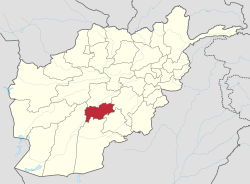Uruzgan
|
Urozgan اروزګان Rozgan (روزګان) |
|
|---|---|
| Province | |

Aerial photo of fields somewhere in Urozgan Province
|
|
 Map of Afghanistan with Urozgan highlighted |
|
| Coordinates (Capital): 32°48′N 66°00′E / 32.8°N 66.0°ECoordinates: 32°48′N 66°00′E / 32.8°N 66.0°E | |
| Country |
|
| Capital | Tarinkot |
| Government | |
| • Governor | Nazeer Ahmad |
| Area | |
| • Total | 12,640 km2 (4,880 sq mi) |
| Population (2012) | |
| • Total | 333,500 |
| • Density | 26/km2 (68/sq mi) |
| Time zone | UTC+4:30 |
| ISO 3166 code | AF-URU |
| Main languages | Hazaragi Pashto |
Urōzgān (Pashto: اروزګان، روزګان; Persian: اروزگان), also spelled as Uruzgan, Oruzgan, Orozgan, or Rozgan, is one of the thirty-four provinces of Afghanistan. Urozgan is in the center of the country, although the area is culturally and tribally linked to Kandahar Province in the south. The population is 333,500, and the province is mostly a tribal society.Tarinkot serves as the capital of the province.
In 2004, the new Daykundi province was carved out of an area in the north, leaving Urozgan with a majority Pashtun population and Daykundi with a majority of Hazaras (see map in infobox for the provincial boundaries that resulted). In 2006, however, Gizab District was taken back from Daykundi and re-annexed to Urozgan, becoming the province's sixth district.
Urozgan province is located in the southern Afghanistan, bordering Zabul and Kandahar to the south, Helmand to the southwest, Daykundi to the north, and Ghazni Province to the east. Urozgan covers an area of 12,640 km2 (1,264,000 ha). Much of the province is mountainous or semi-mountainous terrain, while the rest of the area is made up of flat land.
The region was part of ancient Arachosia, and was ruled by the Medes before it fell to the Achaemenids. In 330 BC, Alexander the Great occupied the area but left it to Seleucids to rule. It was taken by Mauryas later and ruled under Ashoka. By the 7th century, when the Arabs first arrived, it was under the control of the Zunbils before being conquered in the name of Islam by the Saffarids in the 9th century. It fell to the Ghaznavids followed by the Ghurids before the Mongol invasion in the 13th century. The area was ruled by Arghun Khan of Ilkhanate, later by the Timurids, Mughals and Saffavids.
...
Wikipedia
